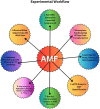Root separation modulates AMF diversity and composition in tomato-potato onion intercropping systems
- PMID: 40143864
- PMCID: PMC11936949
- DOI: 10.3389/fmicb.2025.1554644
Root separation modulates AMF diversity and composition in tomato-potato onion intercropping systems
Abstract
Plant-plant interactions shape arbuscular mycorrhizal fungi (AMF) communities in rhizosphere soil, with tomato/potato-onion intercropping emerging as a promising agro-ecological strategy to optimize resource utilization. However, the role of root separation methods in modulating AMF diversity within intercropping systems remains unclear. Specifically, whether the AMF community in the rhizosphere of tomato and potato-onion intercropping differs from monoculture and how root separation methods modulate these effects. This study evaluates the effects of various root separation methods (no separation, 0.45 μm nylon membrane, 38 μm nylon membrane, and solid separation) on AMF diversity and composition in tomato/potato-onion intercropping and monoculture systems. High-throughput Illumina MiSeq sequencing was used to assess AMF diversity indices (Ace, Chao1, Shannon, and Simpson), and Principal Coordinate Analysis evaluated community structure. Results showed that the non-separation mode achieved the highest Ace and Chao1 indices, indicating greater richness, while intercropping lowered Shannon and Simpson indices. Intercropping significantly reduced Glomerales but increased Paraglomerales, under the non-separation mode. Similarly, it decreased Glomus while increasing Paraglomus in the rhizosphere of both crops. Principal Coordinate Analysis revealed that root separation distinctly altered AMF community structure, reflecting specific barrier effects on AMF interactions. Intercropping increased AMF abundance in the tomato rhizosphere but reduced it in potato-onion as shown by 18S rRNA gene abundance. These findings emphasize that minimizing root separation in intercropping enhances AMF diversity and functionality, providing valuable insights for sustainable agricultural management. Understanding the role of root interactions in shaping AMF communities can help optimizing intercropping strategies to improve soil health and nutrient dynamics.
Keywords: AMF; CMNs; intercropping; plant-plant interaction; root barrier; soil microbial community.
Copyright © 2025 Ibrahim, Ullah, Pan, Lu, Ibrahim, Cao, Liu, Zhou, Wu and Gao.
Conflict of interest statement
The authors declare that the research was conducted in the absence of any commercial or financial relationships that could be construed as a potential conflict of interest.
Figures









Similar articles
-
Intercropping with Potato-Onion Enhanced the Soil Microbial Diversity of Tomato.Microorganisms. 2020 Jun 2;8(6):834. doi: 10.3390/microorganisms8060834. Microorganisms. 2020. PMID: 32498315 Free PMC article.
-
Response of the arbuscular mycorrhizal fungi diversity and community in maize and soybean rhizosphere soil and roots to intercropping systems with different nitrogen application rates.Sci Total Environ. 2020 Oct 20;740:139810. doi: 10.1016/j.scitotenv.2020.139810. Epub 2020 Jun 1. Sci Total Environ. 2020. PMID: 32563865
-
Effects of Intercropping with Potato Onion on the Growth of Tomato and Rhizosphere Alkaline Phosphatase Genes Diversity.Front Plant Sci. 2016 Jun 15;7:846. doi: 10.3389/fpls.2016.00846. eCollection 2016. Front Plant Sci. 2016. PMID: 27379133 Free PMC article.
-
Root exudation under maize/soybean intercropping system mediates the arbuscular mycorrhizal fungi diversity and improves the plant growth.Front Plant Sci. 2024 Jun 14;15:1375194. doi: 10.3389/fpls.2024.1375194. eCollection 2024. Front Plant Sci. 2024. PMID: 38947945 Free PMC article.
-
Spatial variability and environmental drivers of cassava-arbuscular mycorrhiza fungi (AMF) associations across Southern Nigeria.Mycorrhiza. 2022 Jan;32(1):1-13. doi: 10.1007/s00572-021-01058-x. Epub 2022 Jan 4. Mycorrhiza. 2022. PMID: 34981190 Free PMC article. Review.
References
-
- Ali A., Ghani M. I., Ding H., Fan Y., Cheng Z., Iqbal M. (2019a). Co-amended synergistic interactions between arbuscular mycorrhizal fungi and the organic substrate-induced cucumber yield and fruit quality associated with the regulation of the AM-fungal community structure under anthropogenic cultivated soil. Int. J. Mol. Sci. 20:1539. 10.3390/ijms20071539 - DOI - PMC - PubMed
-
- Ali A., Ghani M. I., Elrys A. S., Ding H., Iqbal M., Cheng Z., et al. (2021). Different cropping systems regulate the metabolic capabilities and potential ecological functions altered by soil microbiome structure in the plastic shed mono-cropped cucumber rhizosphere. Agric. Ecosyst. Environ. 318:107486. 10.1016/j.agee.2021.107486 - DOI
-
- Ali A., Ghani M. I., Haiyan D., Iqbal M., Cheng Z., Cai Z. (2020). Garlic substrate induces cucumber growth development and decreases Fusarium wilt through regulation of soil microbial community structure and diversity in replanted disturbed soil. Int. J. Mol. Sci. 21:6008. 10.3390/ijms21176008 - DOI - PMC - PubMed
-
- Ali A., Imran Ghani M., Li Y., Ding H., Meng H., Cheng Z. (2019b). Hiseq base molecular characterization of soil microbial community, diversity structure, and predictive functional profiling in continuous cucumber planted soil affected by diverse cropping systems in an intensive greenhouse region of northern China. Int. J. Mol. Sci. 20:2619. 10.3390/ijms20112619 - DOI - PMC - PubMed
LinkOut - more resources
Full Text Sources
Miscellaneous

